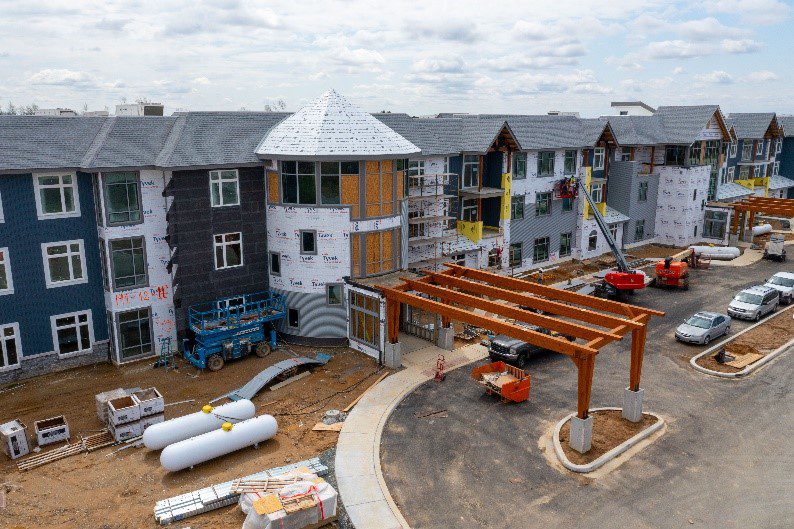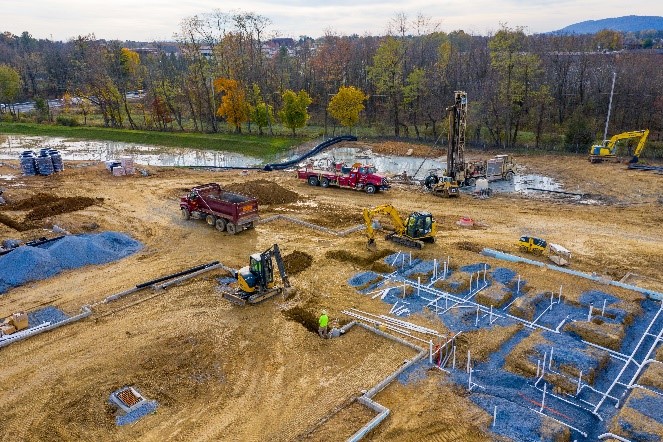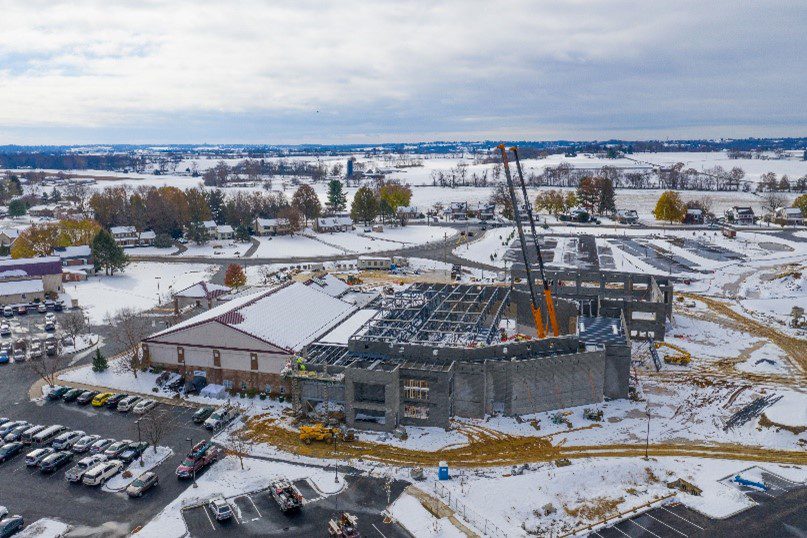
After long, scorching summer days, cooler weather can be a welcome change for construction workers. But colder temperatures bring a unique set of challenges to jobsites.
Winter weather’s impact on construction requires creative solutions and close collaboration. From frozen subgrade and adhesives to icy conditions, contractors have to plan projects around low temperatures and snow to keep construction moving.
That said, there’s no need to shy away from construction during the winter. Your team should have years of experience working around these normal winter challenges, as well as tried-and-true solutions that minimize their impact on the project’s schedule and budget.
Here are five ways winter weather impacts construction, and five ways creative contractors work around them.
1. Frozen Earth Can Cause Challenges for Grading & Foundations
Having stable, compacted ground beneath your building and site is essential to a well-constructed, long-lasting property. Modern machinery and techniques make subgrade work easier, especially when it comes to digging in the hardened winter earth. But challenges can still occur when prolonged cold temperatures lead to subgrade ice.
This underground moisture can make it difficult for workers to properly compact the earth. As the pockets of water trapped in the subgrade freeze, they expand, offsetting the ground around it. Once the earth begins to warm, the ice will thaw, leaving behind pockets in the ground. As the earth settles to fill in those pockets, it disrupts and shifts the land and buildings that lie above.
While contractors can still grade and dig foundations during the winter, you should anticipate that it will take longer than during warmer months. Be sure to allow enough flexibility in your schedule for delays due to snow or other significant wintry conditions. It is also imperative that you find an experienced team that has the equipment and know-how to properly compact the earth to avoid shifting and other long-term problems.
Aside from warmer weather, working with a trusted and experienced site contractor or excavator is your best defense against subgrade ice.
2. Cold Weather Can Weaken Concrete
Concrete is a popular building material, in part because of its strength and durability. However, low temperatures during its pour can present challenges.
Concrete’s strength is dependent on how quickly it dries, and chilly weather slows this process. Freshly poured concrete exposed to temperatures of 40 degrees within the first 24 hours may lose about half its strength, according to the American Concrete Institute. And if it’s cold enough for the concrete to freeze before it dries, it may have to be torn up and poured again.
To help stave off cold weather’s effects, contractors can use concrete blankets that preserve heat loss and slow the drying process. Mixing anti-freezing concrete components to the concrete and ground-thawing machines can also help combat low temperatures.
3. Mortar, Grout, & Adhesives May Not Work
Cooler temperatures will also have an impact on mortar, grout, and adhesives. As the water in these components freezes, small ice crystals can completely alter the chemical composition of these materials. This will weaken their bonding ability and can lead to unsecured components.
 In some cases, contractors can heat the brick, tile, or other building material before applying the bonding agent. They can also cover the completed area as it dries, keeping in the vital heat to ensure a stronger bond. There are some adhesives on the market with added polymers that lower freezing points, as well as adhesives designed with shorter curing times. Depending on your project, these may be options to help beat the cold.
In some cases, contractors can heat the brick, tile, or other building material before applying the bonding agent. They can also cover the completed area as it dries, keeping in the vital heat to ensure a stronger bond. There are some adhesives on the market with added polymers that lower freezing points, as well as adhesives designed with shorter curing times. Depending on your project, these may be options to help beat the cold.
If work is taking place on the interior of an enclosed building, contractors can use temporary heaters to keep the installation area warm enough for the adhesives to set. The building materials should also be stored in a heated area to warm up before work begins. The surface temperature of the installed materials should remain above 50 or so degrees for several days to allow for proper setting.
4. Finishing Drywall Can Be a Challenge
Finishing drywall requires warmer temperatures and the proper humidity to ensure components like drywall joint compound/mud and paint dry properly. If done at temperatures below 50-55 degrees and in a dry environment, your team will risk issues like gaps, cracked drywall mud, poorly bonded boards, and inconsistent paint color. In addition to not looking great, these issues can shorten the lifespan of the walls.
Thankfully, finishing drywall happens on the interior of a building, making it easy to control temperatures throughout the seasons.
Even if the building’s heating system isn’t up and running, portable heaters will help create a better environment for the mud, paint, and the workers applying them. The team will need to maintain these warmer temperatures (around 50-55 degrees) until the material is set and dried.
 5. Snow and Ice Can Slow Progress
5. Snow and Ice Can Slow Progress
Battling the cold is one thing, but snow and ice present their own challenges. Slippery surfaces can make for perilous working conditions if not managed properly.
Before inclement weather, the team can spread salt and other de-icing agents, keeping the site safe for foot and vehicle traffic. Once the snow begins to accumulate, your crew will clear the way so work can resume as quickly as possible. In other cases, some activities may have to be postponed until the snow melts.
This is especially important for activities done high above ground level, on scaffolds and roofs. Even with proper fall protection, it’s best for workers to perform tasks elsewhere until the snow and ice are melted.
Overall, pushing high-risk activities off a few hours or days until conditions are safer shouldn’t have a huge impact on a well-planned project schedule. Small weather-related delays may even be worked into the schedule from the start.
Minimizing the Impact of Winter Weather in Construction
Construction doesn’t stop when it gets cold, and it doesn’t have to. With the right approach and experience, your team can plan your project’s milestones around the seasons to deliver a well-constructed, on-time, and on-budget project.
One of the best ways to maintain a schedule during winter is to choose the right project delivery method for your project. This will influence everything from the team’s composition to the flow of information to the responsibilities of each party.
The best delivery method, especially for projects requiring long-term planning, is the design-build project approach. It aligns all the stakeholders in the beginning, so everyone can get on board and plan their weather-sensitive items for warmer months. They’ll be able to fill in the colder months with other necessary tasks that can be completed regardless of temperature, leading to a more efficient schedule, fewer delays, and better results.
At Horst Construction, we believe in the benefits of the design-build project approach. We feel that early collaboration is the key to a successful construction project, and design-build sets the stage for collaboration from a project’s conceptualization through completion.
Oops! We could not locate your form.

 5. Snow and Ice Can Slow Progress
5. Snow and Ice Can Slow Progress

